Pipits and wagtails are in the order Passeriformes and family Motacillidae. The family Motacillidae is one of the most widespread in the world and is divided into 6 genera, 65 species, 212 taxa. The longclaws are entirely restricted to the Afrotropics, and the wagtails are predominantly found in Europe, Africa and Asia, with two species migrating and breeding in Alaska. Three genera are found in the Holarctic: Anthus (pipits), Motacilla (wagtails) and Dendronanthus (forest wagtail). Three are found only in Africa: Hemimacronyx (yellow-breasted pipit (H. chloris), and sharpe's longclaw (H. sharpei)), Tmetothylacus (golden pipit (T. tenellus)) and Macronyx (longclaws)).
Pipits and wagtails are small to medium sized birds (14 to 21 cm, 12 to 50 g) with long tails (especially wagtails, which often bob up and down the tail, especially while foraging), bodies, legs and claws (reaching up to 4 cm in some species of longclaw). They have thin, pointed bills with a small hump above the nostril. Sexes are of similar size, but males may be slightly larger and/or have longer wings.
Pipits are quite drab; they have brown plumage with streaking on the breast. It is difficult to identify different species of pipits in the field.
Wagtails, on the other hand, often have bright breeding plumage with white, black, gray, yellow and green feathers. Male and female wagtails are dimorphic in plumage; both females and juveniles tend to have less coloration than males and their plumage resembles male winter plumage. Pipits show no sexual dimorphism in plumage.
Overall the robust longclaws are larger than the pipits and wagtails.
Pipits and wagtails have a worldwide distribution. However, most species are found in Eurasia and Africa. Forty-six percent of pipit and wagtail species are found in Africa, 21 percent in Asia and 16 percent in the New World, Africa and Eurasia.
Pipits and wagtails can be found in a variety of habitats from temperate to tropical and polar regions. They prefer open and semi-open habitat. Suitable habitat includes: shrubland, savanna, tundra, dunes, salt marshes, desert, rocky shorelines, roadsides, creeksides, agricultural fields and urban areas.
For the most part, pipits and wagtails are monogamous. However, polygyny and extra pair copulations do occur. The birds usually form pairs as soon as they reach their breeding grounds. The same pairs may nest together season to season. Pipits and wagtails are territorial and defend their nest site by singing from perches and performing song flights. Bill raising and wing vibration are also used during displays. In addition, some pipits exhibit courtship feeding.
Breeding in pipits and wagtails coincides with prey abundance. Nest building takes 4 to 20 days; nests are often placed on the ground, in trees, or in cavities in banks, cliffs, buildings or walls. Nests are usually protected by rocks and vegetation or are placed in a small hole or excavated cavity. They are cup shaped and made of grass, willow, bark, lichen, moss, leaves and twigs. Nests may be lined with grass, fur, feathers and rootlets, and are sometimes held together with mud. Some pipits build domed nests. Clutch size is usually 4 to 7 for wagtails and 3 to 7 for pipits (usually five). Eggs are 13 to 16 by 17 to 21 mm and are white to light green to dark olive with dark spots. Incubation lasts 10 to 15 days. Only female pipits incubate, although males bring females food while they are on the nest. Both male and female wagtails incubate, but females spend more time on the eggs than males. Hatching is synchronous and the altricial young are brooded for 5 to 6 days. Both adults feed the nestlings and remove fecal sacks. Young are primarily fed insects. Fledging occurs after 12 to 15 days, but the chicks may leave as early as 9 days after hatching if the nest is disturbed. Chicks often leave the nest before they can fly, and they continue to be fed by their parents for 14 to 18 days.
Some pipits and wagtails are solitary, and others are gregarious. Many species are solitary during breeding but will flock during the non-breeding season. They are mainly terrestrial, but will perch on rocks, shrubs and trees. They are territorial during the breeding season and defend their territories using song and display flights. Song flights are more developed in pipits than wagtails; they last from 30 seconds to 40 minutes and the male can reach up to 90 meters in height. Wagtails often sing from bushes or tussocks and while in flight. The birds walk rather than hop along the ground are known to pump or wag their tails up and down as they forage. Both pipits and wagtails have an undulating flight pattern.
Most pipits and wagtails are migratory, although some southern species may be residents. The birds can double their weight before beginning migration and some species of wagtail cross the Sahara non-stop during migration.
Pipits of the genus Anthus will apply ants to their plumage for cleaning, a behavior called anting. Both pipits and wagtails bathe in shallow standing water. They also undergo a complete molt after breeding and a partial molt before breeding.
Pipits and wagtails are primarily insectivores although they sometimes eat seeds, berries and other prey. They usually forage on the ground, but will occasionally catch aerial insects. They also forage in shallow water for aquatic invertebrates and catch insects on foliage or near the surface of water. Tail length affects the birds’ maneuverability and therefore their ability to catch insects in flight; species with longer tails tend to do more fly catching. Wagtails sometimes forage alongside of groups of cattle, sheep and wild ungulates. These animals stir up insects and make it easier for the birds to find and catch them.
The pipits are a cosmopolitan genus, Anthus, of small passerine birds with medium to long tails. The pipits are generally highly conservative in appearance. They are generally between 16–21 cm in length, although the smallest species, the Short-tailed Pipit, is only 11.5–12.5 cm. Like all members of the family they are slender, short necked birds with long tails, long slender legs with elongated (in some cases very elongated) hind claws. The length of the hindclaw varies with the habits of the species, more arboreal species have shorter, more curved hindclaws than the more terrestrial species. The bills are generally long, slender and pointed. In both size and plumage there is little differences between the sexes. One unusual feature of the pipits, which they share in common with the rest of their family but not the rest of the passerines, is that the tertials on the wing entirely cover the primary flight feathers. This is thought to be a feature to protect the primaries, which are important to flight, from the sun, which causes the feathers to fade and become brittle if not protected.
The plumage of the pipits is generally drab and brown, buff or faded white. The undersides are usually darker than the top, and there is a variable amount of barring and streaking on the back, wings and breast. The drab mottled brown colours provide some camouflage against the soil and stones they are generally found on. The Yellow-breasted Pipit, if it is retained in this genus, is quite atypical in having bright yellow plumage on the throat breast and belly.
Pipits are morphologically similar to some larks. However the two groups are quite distantly related: the lark family Alaudidae is part of the Sylvioidea superfamily, rather than the Passeroidea, where the pipits are placed. Morphological differences between the two groups of birds are in fact plentiful. Anatomical differences include a differently-structured syrinx, differences in the structure of the tarsus, and in many lark genera, the presence of a distinct tenth primary, a fourth tertial, and feathers at least partially covering the nostrils. Bill shape differs between larks and pipits: larks have an evenly sloping culmen, whereas most pipits have a small hump over the nostrils, and lark bills are generally heavier, reflecting differences in diet. There are differences in the feather tracts of the two groups: while many larks have crests, no pipit does; pipits have only one prominent row of scapulars, whereas larks have two.
The pipits are active terrestrial birds that usually spend most of their time on the ground. They will fly in order to display during breeding, while migrating and dispersing, and also when flushed by danger. A few species make use of trees, perching in them and flying to them when disturbed. Low shrubs, rocks and termite nests may also be used as vantage points. Like their relatives the wagtails, pipits engage in tail-wagging. The way in which a pipit does this can provide clues to its identity in otherwise similar looking species. Upland Pipits, for example, flick their tails quite quickly, as opposed to Olive-backed Pipits which wag their tails more gently.In general pipits move their tails quite slowly. The Buff-bellied Pipit wags its tail both up and down and from side to side. The exact function of tail-wagging is unclear; in the related wagtails it is thought to be a signal to predators of vigilance.
Africa Wild Bird Book
Family Motacillidae (Wagtails, Pipits) Index
Family Motacillidae (Wagtails, Pipits)
Motacilla flava Western Yellow Wagtail 714
Motacilla citreola Citrine Wagtail
Motacilla capensis Cape Wagtail 713
Motacilla cinerea Grey Wagtail 715
Motacilla clara Mountain Wagtail 712
Motacilla aguimp African Pied Wagtail 711
Tmetothylacus tenellus Golden Pipit 726
Macronyx capensis Cape Longclaw 727
Macronyx croceus Yellow-throated Longclaw 728
Macronyx ameliae Rosy-throated Longclaw 730
Anthus cinnamomeus African Pipit 716
Anthus hoeschi Mountain Pipit 901
Anthus similis Long-billed Pipit 717
Anthus nyassae Wood Pipit 909
Anthus vaalensis Buffy Pipit 719
Anthus longicaudatus Long-tailed Pipit 719.1
Anthus leucophrys Plain-backed Pipit 718
Anthus trivialis Tree Pipit 722
Anthus cervinus Red-throated Pipit 903
Anthus lineiventris Striped Pipit 720
Anthus crenatus African Rock Pipit 721
Anthus brachyurus Short-tailed Pipit 724
Anthus caffer Bushveld Pipit 723
Anthus pseudosimilis Kimberley Pipit 717.2
Anthus chloris Yellow-breasted Pipit 725
Motacilla flava Western Yellow Wagtail 714
Motacilla citreola Citrine Wagtail
Motacilla capensis Cape Wagtail 713
Motacilla cinerea Grey Wagtail 715
Motacilla clara Mountain Wagtail 712
Motacilla aguimp African Pied Wagtail 711
Tmetothylacus tenellus Golden Pipit 726
Macronyx capensis Cape Longclaw 727
Macronyx croceus Yellow-throated Longclaw 728
Macronyx ameliae Rosy-throated Longclaw 730
Anthus cinnamomeus African Pipit 716
Anthus hoeschi Mountain Pipit 901
Anthus similis Long-billed Pipit 717
Anthus nyassae Wood Pipit 909
Anthus vaalensis Buffy Pipit 719
Anthus longicaudatus Long-tailed Pipit 719.1
Anthus leucophrys Plain-backed Pipit 718
Anthus trivialis Tree Pipit 722
Anthus cervinus Red-throated Pipit 903
Anthus lineiventris Striped Pipit 720
Anthus crenatus African Rock Pipit 721
Anthus brachyurus Short-tailed Pipit 724
Anthus caffer Bushveld Pipit 723
Anthus pseudosimilis Kimberley Pipit 717.2
Anthus chloris Yellow-breasted Pipit 725
- nan
- Posts: 26340
- Joined: Thu May 31, 2012 9:41 pm
- Country: Switzerland
- Location: Central Europe
- Contact:
Western Yellow Wagtail
714. Western Yellow Wagtail Motacilla flava (Gelkwikkie)
Order: Passeriformes. Family: Motacillidae
Description
Size 16-18 cm. It varies hugely in appearance across its large range, with some authorities considering many of the subspecies separate species. In general, the yellow wagtail is a yellow and green bird, with a greyish to black bill and slate-grey to black legs.
The breeding male has yellow underparts and a green back, with two yellow-white bars on the coverts of the almost black wings.
Outside of the breeding season, both the male and female are duller, with a brown back and paler yellow underparts.
The juvenile resembles the female, yellowish brown above and pale buff below, has distinctive buff on the throat and a brownish breast-bib, as well as pale yellow marks on the head.
Female and non-breeding male, which are normally seen in the region, differ widely in the amount of yellow on the underparts as a result of racial variation
Can be confused only with Grey Wagtail, but this species is smaller and has a much shorter tail and a green (not blue-grey) back. The head colour is variable, according to race.
Distribution
Breeds from Europe and northern Africa through Asia to Alaska and north-western Canada, migrating south in the non-breeding season to India, south-east Asia, Australia and sub-Saharan Africa, from Senegal to Somalia south to southern Africa. Here it is fairly common in patches of Zimbabwe, Mozambique, Namibia, Botswana (especially the Okavango Delta) and South Africa, mainly in Gauteng Province.
Habitat
Short, cropped, grassy verges of coastal lagoons, sewage ponds and wetland.
Movements and migrations
Non-breeding migrant to southern Africa, arriving in the period from October-November in the north and November-December in the south, leaving in small flocks from March-April throughout the region.
Diet
Its diet in southern Africa has not been studied, however in Nigeria it eats insects and other invertebrates, foraging on the ground and in the air.
Breeding
It is monogamous, nesting in solitary pairs which cooperate to defend a territory around the nesting site. The nest is a simple grassy cup lined with hair that is built by the female and placed on the ground in a shallow scrape. Between 4 and 6 eggs are laid¸ and are incubated by both adults for 11 to 13 days. The chicks are fed by both adults for the 11 to 14 days that they are in the nest and for several weeks after fledging.
Call
A weak, thin tseeep.
http://www.xeno-canto.org/species/Motacilla-flava
Status
Uncommon to locally common summer visitor. Sometimes in flocks.
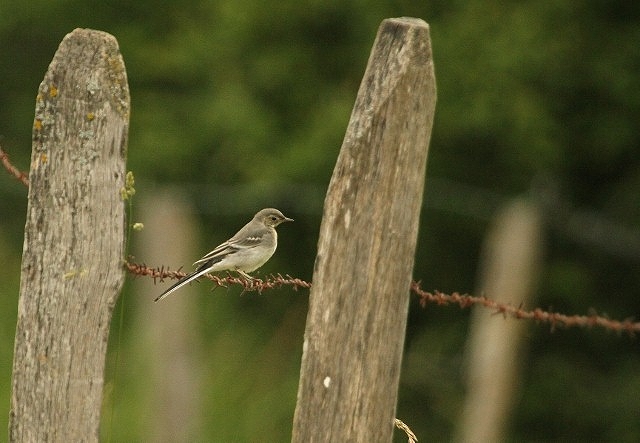
M. f. flava female.
Order: Passeriformes. Family: Motacillidae
Description
Size 16-18 cm. It varies hugely in appearance across its large range, with some authorities considering many of the subspecies separate species. In general, the yellow wagtail is a yellow and green bird, with a greyish to black bill and slate-grey to black legs.
The breeding male has yellow underparts and a green back, with two yellow-white bars on the coverts of the almost black wings.
Outside of the breeding season, both the male and female are duller, with a brown back and paler yellow underparts.
The juvenile resembles the female, yellowish brown above and pale buff below, has distinctive buff on the throat and a brownish breast-bib, as well as pale yellow marks on the head.
Female and non-breeding male, which are normally seen in the region, differ widely in the amount of yellow on the underparts as a result of racial variation
Can be confused only with Grey Wagtail, but this species is smaller and has a much shorter tail and a green (not blue-grey) back. The head colour is variable, according to race.
Distribution
Breeds from Europe and northern Africa through Asia to Alaska and north-western Canada, migrating south in the non-breeding season to India, south-east Asia, Australia and sub-Saharan Africa, from Senegal to Somalia south to southern Africa. Here it is fairly common in patches of Zimbabwe, Mozambique, Namibia, Botswana (especially the Okavango Delta) and South Africa, mainly in Gauteng Province.
Habitat
Short, cropped, grassy verges of coastal lagoons, sewage ponds and wetland.
Movements and migrations
Non-breeding migrant to southern Africa, arriving in the period from October-November in the north and November-December in the south, leaving in small flocks from March-April throughout the region.
Diet
Its diet in southern Africa has not been studied, however in Nigeria it eats insects and other invertebrates, foraging on the ground and in the air.
Breeding
It is monogamous, nesting in solitary pairs which cooperate to defend a territory around the nesting site. The nest is a simple grassy cup lined with hair that is built by the female and placed on the ground in a shallow scrape. Between 4 and 6 eggs are laid¸ and are incubated by both adults for 11 to 13 days. The chicks are fed by both adults for the 11 to 14 days that they are in the nest and for several weeks after fledging.
Call
A weak, thin tseeep.
http://www.xeno-canto.org/species/Motacilla-flava
Status
Uncommon to locally common summer visitor. Sometimes in flocks.

M. f. flava female.
Kgalagadi lover… for ever
https://safrounet.piwigo.com/
https://safrounet.piwigo.com/
- nan
- Posts: 26340
- Joined: Thu May 31, 2012 9:41 pm
- Country: Switzerland
- Location: Central Europe
- Contact:
Western Yellow Wagtail Photos
714. Western Yellow Wagtail Motacilla flava (Gelkwikkie)
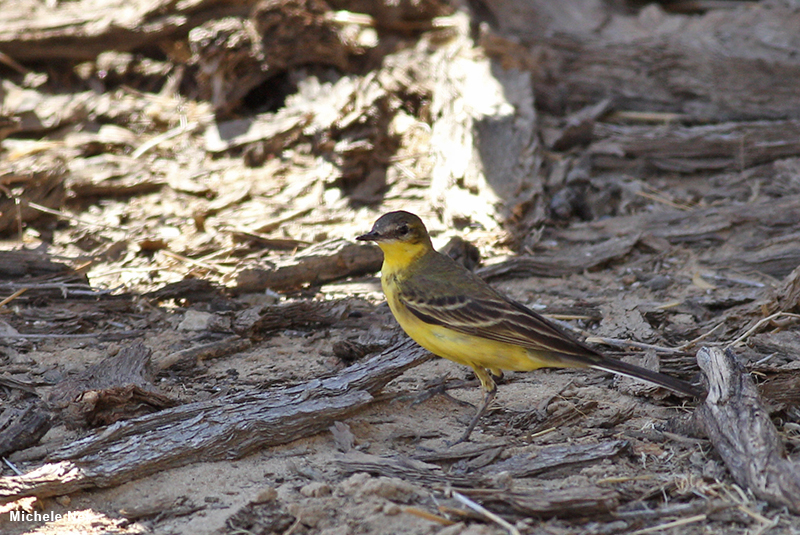 © Michele Nel
© Michele Nel
Marie se Gat, KTP - 31/12/2016
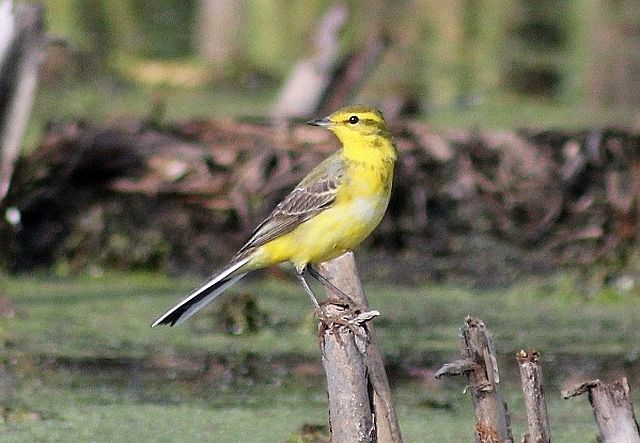 © Amoli
© Amoli
Rietvlei Nature Reserve, Gauteng
Links:
http://sabap2.adu.org.za/docs/sabap1/714.pdf
http://sabap2.adu.org.za/spp_summary.ph ... §ion=3
Kenneth Newman. What's that Bird?: A Starter's Guide to Birds of Southern Africa
The Illustrated Encyclopedia Of European Birds
Wikipedia
 © Michele Nel
© Michele NelMarie se Gat, KTP - 31/12/2016
 © Amoli
© AmoliRietvlei Nature Reserve, Gauteng
Links:
http://sabap2.adu.org.za/docs/sabap1/714.pdf
http://sabap2.adu.org.za/spp_summary.ph ... §ion=3
Kenneth Newman. What's that Bird?: A Starter's Guide to Birds of Southern Africa
The Illustrated Encyclopedia Of European Birds
Wikipedia
Kgalagadi lover… for ever
https://safrounet.piwigo.com/
https://safrounet.piwigo.com/
- Mel
- Global Moderator
- Posts: 28290
- Joined: Sat May 19, 2012 12:31 pm
- Country: Germany
- Location: Föhr
- Contact:
Cape Wagtail
713. Cape Wagtail Motacilla capensis (Gewone Kwikkie)
Order: Passeriformes. Family: Motacillidae
Description
Length of about 20 cm and a wingspan of about 65 cm. Dull-looking bird with grey-brown upperparts. It has a longish dark grey-brown tail, constantly wagging, that is characteristic of the wagtail family.
Adult: Upper parts and face olive-grey, with creamy-white supercilium and narrow crescent under eye. Tail dark grey-brown. Outermost 2 rectrices white (T5 often blackish along inner web), T3-T4 usually with white outer webs and tips; T1 with paler grey margins when fresh. Flight feathers, and greater and median coverts dark grey-brown, narrowly edged pale buff-grey. Lesser coverts olive-grey, matching back. Axillaries grey, underwing coverts whitish. Throat, malar area and upper breast whitish, with a dark grey, often rather irregular gorget, broadest in centre. Remainder of underparts creamy white, flanks extensively washed olive-grey. Bill black. Eyes dark brown. Legs and feet brownish black.
Northern races have breast-band absent or vestigial.
Young birds are duller and have yellowish underparts.
Similar species: African Pied Wagtail juvenile has striking black and white wings. Mountain Wagtail has much longer tail; upper parts more blue-grey, underparts pure white. Western Yellow Wagtail lacks pectoral band or chest spot, and usually has some yellow wash on belly and vent; voice different. Grey Wagtail always has markedly yellow belly and longer tail.
Distribution
Although it occupies Uganda, eastern DRC and Kenya, the bulk of its population extends from southern DRC through Zambia and Angola to southern Africa. Here it is especially common across South Africa, Swaziland and Lesotho, while more scarce in Namibia, northern and south-eastern Botswana, Zimbabwe and southern Mozambique.
Habitat
Occurs almost anywhere that has open ground adjacent to water, also favouring the rocky coastline, farms, villages, cultivated land, parks, gardens and urban centres.
Diet
Usually forages by walking purposefully, picking or darting after insects. Also wades through shallow water, picking prey in or over water. Mainly insects, dead or alive, including moths, dragonflies, ants, caterpillars, beetles, mosquitoes and termites
Breeding
Monogamous, territorial solitary nester, with pairs staying together over multiple breeding seasons. While breeding males often fiercely attack their reflection in mirrors. The nest is built by sexes in about 2-10 days, consisting of a cup made of a wide range of materials, including grass, weeds, roots, reeds, pine needles, rags, seed pods and string, lined with hair, rootlets, wool and feathers. It is typically placed in a recess in a steep bank, tree, bush or commonly in a man-made site. Egg-laying season is year-round, peaking from about July-December. It lays 1-5 dull yellow eggs, which are incubated by both sexes for about 13-15 days. The chicks are fed by both parents, leaving the nest after about 14-18 days. They are still fed by the adults for another 20-25 days, becoming fully independent up to about 44 days after fledging, rarely up to 60 days.
Call
The Cape Wagtail’s voice is a jumble of tweep-tweep notes, most commonly sung from a raised perch or a tsee chee chee call. Listen to Bird Call.
Status
Common resident.
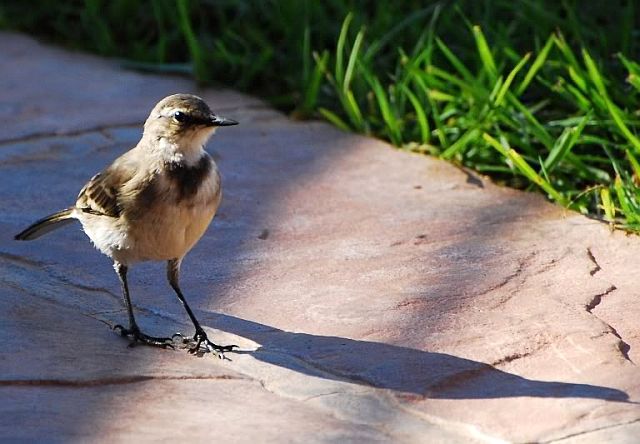
Order: Passeriformes. Family: Motacillidae
Description
Length of about 20 cm and a wingspan of about 65 cm. Dull-looking bird with grey-brown upperparts. It has a longish dark grey-brown tail, constantly wagging, that is characteristic of the wagtail family.
Adult: Upper parts and face olive-grey, with creamy-white supercilium and narrow crescent under eye. Tail dark grey-brown. Outermost 2 rectrices white (T5 often blackish along inner web), T3-T4 usually with white outer webs and tips; T1 with paler grey margins when fresh. Flight feathers, and greater and median coverts dark grey-brown, narrowly edged pale buff-grey. Lesser coverts olive-grey, matching back. Axillaries grey, underwing coverts whitish. Throat, malar area and upper breast whitish, with a dark grey, often rather irregular gorget, broadest in centre. Remainder of underparts creamy white, flanks extensively washed olive-grey. Bill black. Eyes dark brown. Legs and feet brownish black.
Northern races have breast-band absent or vestigial.
Young birds are duller and have yellowish underparts.
Similar species: African Pied Wagtail juvenile has striking black and white wings. Mountain Wagtail has much longer tail; upper parts more blue-grey, underparts pure white. Western Yellow Wagtail lacks pectoral band or chest spot, and usually has some yellow wash on belly and vent; voice different. Grey Wagtail always has markedly yellow belly and longer tail.
Distribution
Although it occupies Uganda, eastern DRC and Kenya, the bulk of its population extends from southern DRC through Zambia and Angola to southern Africa. Here it is especially common across South Africa, Swaziland and Lesotho, while more scarce in Namibia, northern and south-eastern Botswana, Zimbabwe and southern Mozambique.
Habitat
Occurs almost anywhere that has open ground adjacent to water, also favouring the rocky coastline, farms, villages, cultivated land, parks, gardens and urban centres.
Diet
Usually forages by walking purposefully, picking or darting after insects. Also wades through shallow water, picking prey in or over water. Mainly insects, dead or alive, including moths, dragonflies, ants, caterpillars, beetles, mosquitoes and termites
Breeding
Monogamous, territorial solitary nester, with pairs staying together over multiple breeding seasons. While breeding males often fiercely attack their reflection in mirrors. The nest is built by sexes in about 2-10 days, consisting of a cup made of a wide range of materials, including grass, weeds, roots, reeds, pine needles, rags, seed pods and string, lined with hair, rootlets, wool and feathers. It is typically placed in a recess in a steep bank, tree, bush or commonly in a man-made site. Egg-laying season is year-round, peaking from about July-December. It lays 1-5 dull yellow eggs, which are incubated by both sexes for about 13-15 days. The chicks are fed by both parents, leaving the nest after about 14-18 days. They are still fed by the adults for another 20-25 days, becoming fully independent up to about 44 days after fledging, rarely up to 60 days.
Call
The Cape Wagtail’s voice is a jumble of tweep-tweep notes, most commonly sung from a raised perch or a tsee chee chee call. Listen to Bird Call.
Status
Common resident.

God put me on earth to accomplish a certain amount of things. Right now I'm so far behind that I'll never die.
- Mel
- Global Moderator
- Posts: 28290
- Joined: Sat May 19, 2012 12:31 pm
- Country: Germany
- Location: Föhr
- Contact:
Cape Wagtail Photos
713. Cape Wagtail Motacilla capensis (Gewone Kwikkie)
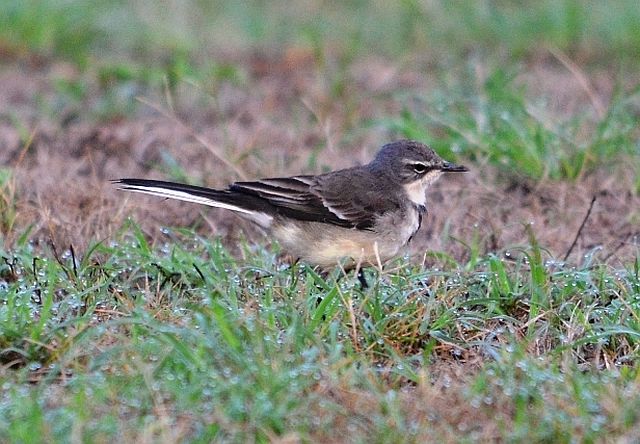
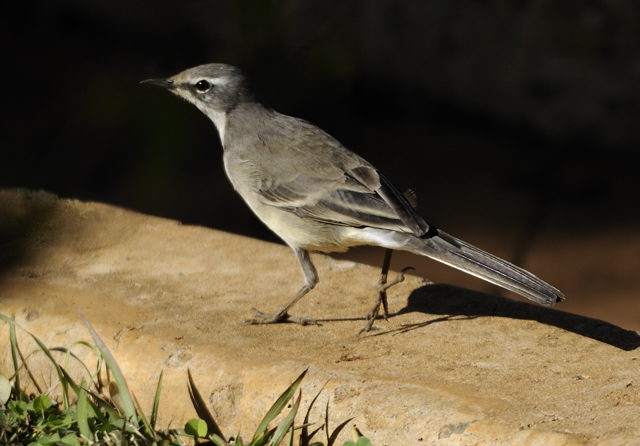 © Dewi
© Dewi
Pilanesberg
 © nan
© nan
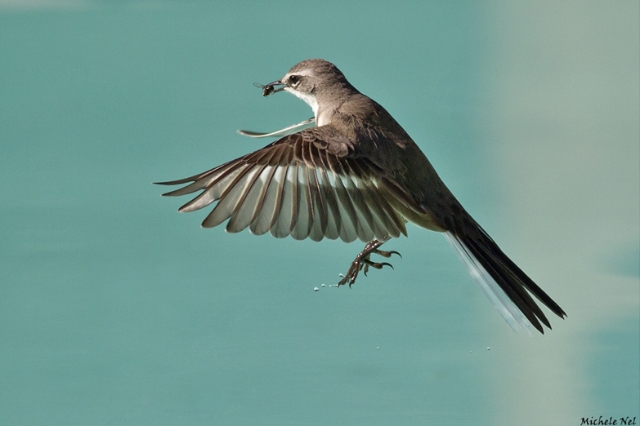 © Michele Nel
© Michele Nel
 © PJL
© PJL
Garden Port Elisabth, Eastern Cape
Links:
Species text Sabap1
Sabap2

 © Dewi
© DewiPilanesberg
 © nan
© nan © Michele Nel
© Michele Nel © PJL
© PJLGarden Port Elisabth, Eastern Cape
Links:
Species text Sabap1
Sabap2
God put me on earth to accomplish a certain amount of things. Right now I'm so far behind that I'll never die.
- nan
- Posts: 26340
- Joined: Thu May 31, 2012 9:41 pm
- Country: Switzerland
- Location: Central Europe
- Contact:
Grey Wagtail
715. Grey Wagtail Motacilla cinerea (Gryskwikkie)
Order: Passeriformes. Family: Motacillidae
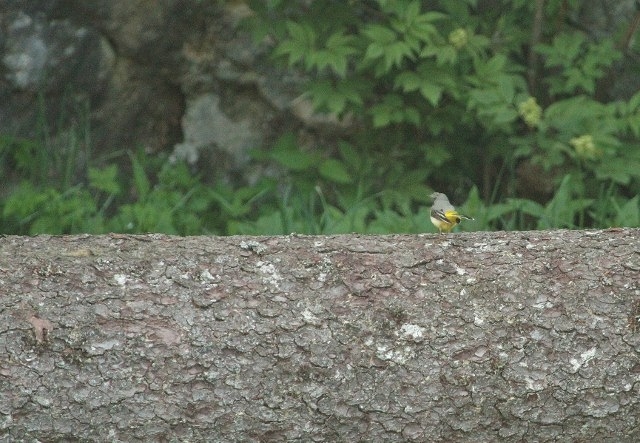
Description
Size 17-19 cm. The Grey Wagtail has a pale blue-grey back and the yellow vent contrasting with whitish underparts makes it distinctive. The rump is greenish-yellow, the tail is black with white edges and there is a narrow white supercilium and a broken eye ring. The bill is black and the legs are dark brown to purplish-brown. During the breeding season, the male grey wagtail develops a bold face pattern with white stripes and a jet-black bib.
The breeding male has a black throat that is edged by whitish moustachial stripes.
In non-breeding plumage the black on throat is reduced to a speckled area.
The female differs in having a mottled buffy-white chin and throat and paler yellow underparts.
The juvenile is similar to the adult female, but with buffy underpart and has a bright yellow vent.
Similar species: This species might be mistaken for Western Yellow Wagtail but has a blue-grey (not green) back that contrasts with its greenish yellow rump. The flanks and vent are a bright sulphur-yellow. The Grey Wagtail is slenderer with a much longer, more black and white tail, as well as a broad pale wing bar that is most visible when it is in flight.
Distribution
Breeds across western Europe through Turkey, Afghanistan and Iran to central Asia; in the non-breeding season most of these populations head south to Arabia, India, south-east Asia and north-east Africa, from Sudan to northern Tanzania. It is a vagrant to many other parts of Africa, including southern Africa, such as in Zimbabwe's eastern highlands and adjacent Mozambique, parts of South Africa, west-central Namibia, the Caprivi Strip and eastern Botswana.
Habitat
Verges of fast-flowing streams and ponds.
Diet
The Grey Wagtail feeds mainly on a variety of insects. Its prey is usually caught from shallow water or on the ground while walking or running, or occasionally after sallies into the air from a perch hanging over water. Whilst feeding, the grey wagtail fervently wags its long tail in a territorial display to other wagtails that a particular stretch of water is occupied.
Breeding
In Europe, the Grey Wagtail breeds from the end of March to August, with most birds breeding from April onwards. A monogamous species, pair bonds are formed with male courtship displays involving a parachuting flight, in which the male descends from a tree with the wings lowered and spread, tail depressed and the yellow rump feathers puffed, singing continuously until it reaches the ground. The cup-shaped nest is built by both the male and female grey wagtail, and placed on a rock ledge, in a crevice in a river bank, or often on a ledge in a wall, under a bridge or in a drainpipe. Three to seven eggs are laid, and are incubated by both adults for 11 to 13 days. The chicks are fed by both adults for the 11 to 13 days that they are in the nest and for 2 to 3 weeks after they fledge. Often the male grey wagtail cares for the fledglings alone, as the female may lay a second clutch.
Call
A single, sharp tit. Listen to Bird Call.
Status
Rare summer vagrant.
Order: Passeriformes. Family: Motacillidae

Description
Size 17-19 cm. The Grey Wagtail has a pale blue-grey back and the yellow vent contrasting with whitish underparts makes it distinctive. The rump is greenish-yellow, the tail is black with white edges and there is a narrow white supercilium and a broken eye ring. The bill is black and the legs are dark brown to purplish-brown. During the breeding season, the male grey wagtail develops a bold face pattern with white stripes and a jet-black bib.
The breeding male has a black throat that is edged by whitish moustachial stripes.
In non-breeding plumage the black on throat is reduced to a speckled area.
The female differs in having a mottled buffy-white chin and throat and paler yellow underparts.
The juvenile is similar to the adult female, but with buffy underpart and has a bright yellow vent.
Similar species: This species might be mistaken for Western Yellow Wagtail but has a blue-grey (not green) back that contrasts with its greenish yellow rump. The flanks and vent are a bright sulphur-yellow. The Grey Wagtail is slenderer with a much longer, more black and white tail, as well as a broad pale wing bar that is most visible when it is in flight.
Distribution
Breeds across western Europe through Turkey, Afghanistan and Iran to central Asia; in the non-breeding season most of these populations head south to Arabia, India, south-east Asia and north-east Africa, from Sudan to northern Tanzania. It is a vagrant to many other parts of Africa, including southern Africa, such as in Zimbabwe's eastern highlands and adjacent Mozambique, parts of South Africa, west-central Namibia, the Caprivi Strip and eastern Botswana.
Habitat
Verges of fast-flowing streams and ponds.
Diet
The Grey Wagtail feeds mainly on a variety of insects. Its prey is usually caught from shallow water or on the ground while walking or running, or occasionally after sallies into the air from a perch hanging over water. Whilst feeding, the grey wagtail fervently wags its long tail in a territorial display to other wagtails that a particular stretch of water is occupied.
Breeding
In Europe, the Grey Wagtail breeds from the end of March to August, with most birds breeding from April onwards. A monogamous species, pair bonds are formed with male courtship displays involving a parachuting flight, in which the male descends from a tree with the wings lowered and spread, tail depressed and the yellow rump feathers puffed, singing continuously until it reaches the ground. The cup-shaped nest is built by both the male and female grey wagtail, and placed on a rock ledge, in a crevice in a river bank, or often on a ledge in a wall, under a bridge or in a drainpipe. Three to seven eggs are laid, and are incubated by both adults for 11 to 13 days. The chicks are fed by both adults for the 11 to 13 days that they are in the nest and for 2 to 3 weeks after they fledge. Often the male grey wagtail cares for the fledglings alone, as the female may lay a second clutch.
Call
A single, sharp tit. Listen to Bird Call.
Status
Rare summer vagrant.
Kgalagadi lover… for ever
https://safrounet.piwigo.com/
https://safrounet.piwigo.com/
- nan
- Posts: 26340
- Joined: Thu May 31, 2012 9:41 pm
- Country: Switzerland
- Location: Central Europe
- Contact:
Grey Wagtail Photos
715. Grey Wagtail Motacilla cinerea (Gryskwikkie)

Female
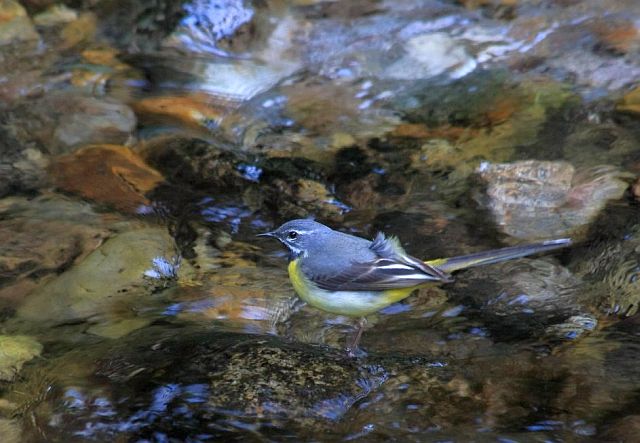 © Toko
© Toko
Male
Links:
Sabap2
ARKive
Mark Golley. Birdwatcher's Pocket Field Guide

Female
 © Toko
© TokoMale
Links:
Sabap2
ARKive
Mark Golley. Birdwatcher's Pocket Field Guide
Kgalagadi lover… for ever
https://safrounet.piwigo.com/
https://safrounet.piwigo.com/
-
Sharifa
Mountain Wagtail
712. Mountain Wagtail (formerly known as Long-tailed Wagtail) Motacilla clara (Bergkwikkie)
Order: Passeriformes. Family: Motacillidae
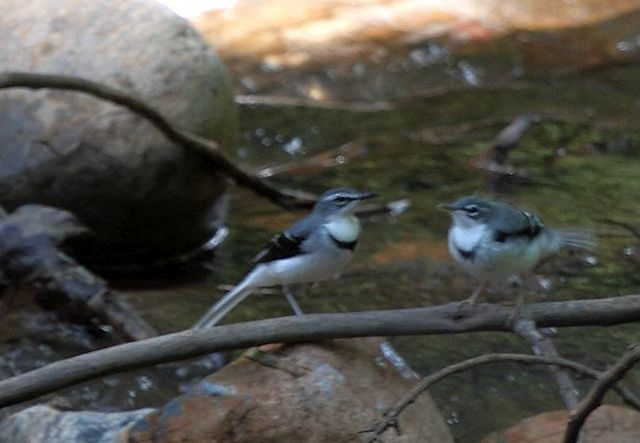
Description
19-20 cm. An active, restless bird. The unmarked, greyish-brown upperparts, long tail and black and white zebra pattern to wings, combined with the narrow, dark grey breast band, are diagnostic. The overall appearance is crisp and neat; the back is blue-grey, the throat is pure white with a small black chest band and there is a straight white stripe above the eye. Sexes alike.
Juvenile is browner than the adult.
Similar species: It resembles the Cape Wagtail but prefers rocky mountain streams in forests. It also shows more extensive white in the wings and is a more slender bird and has pinkish- grey, not black, legs and a much longer tail.
Distribution
Occurs in isolated patches across sub-Saharan Africa, from Guinea to Ethiopia south to Southern Africa. Here it is locally common in the north and eastern highlands of Zimbabwe and adjacent Mozambique, as well as in Swaziland and eastern South Africa, from Limpopo Province to the Eastern Cape.
Habitat
It generally prefers small rivers and streams surrounded by forested hills, especially with waterfalls and flat rocks immersed in shallow water, surrounded by hills with forest, woodland or dense thicket. It may also occupy forest paths, tracks and roads, occasionally moving into gardens. Usually it forages on large flat rocks in mountain streams or near waterfalls, but may also occur along rivers in woodland and coastal thickets.
Diet
Mainly insects, occasionally tadpoles. It mainly eats insects (especially flies), doing most of its foraging along watercourses, searching for prey on rocks, in sand and shallow water.
Breeding
Found in pairs when breeding, otherwise in small family groups. Monogamous, territorial solitary nester, usually with a life-long pair bond. Cup nest usually placed under rock overhang, close to water. The nest is built by both sexes, consisting of a bulky cup lined with rootlets, plant stems and fibrous tissues. Egg-laying season is from August-May, peaking from September-December. It lays 1-4 eggs, which are incubated by both sexes for about 13-14 days. The chicks are fed by both parents and brooded constantly for the first 3-4 days or so of their lives, after which brooding is intermittent, ceasing completely when they reach about 6-8 days old. They eventually leave the nest at approximately 14-18 days old, remaining in the adults territory for roughly 19-48 more days.
Uncommon host of the Red-chested Cuckoo
Call
A variety of high pitched notes and trills. Calls chirrup on taking flight; also sings ti-tuu-ui-tui-tui.
Status
Generally uncommon and localised resident.
Order: Passeriformes. Family: Motacillidae

Description
19-20 cm. An active, restless bird. The unmarked, greyish-brown upperparts, long tail and black and white zebra pattern to wings, combined with the narrow, dark grey breast band, are diagnostic. The overall appearance is crisp and neat; the back is blue-grey, the throat is pure white with a small black chest band and there is a straight white stripe above the eye. Sexes alike.
Juvenile is browner than the adult.
Similar species: It resembles the Cape Wagtail but prefers rocky mountain streams in forests. It also shows more extensive white in the wings and is a more slender bird and has pinkish- grey, not black, legs and a much longer tail.
Distribution
Occurs in isolated patches across sub-Saharan Africa, from Guinea to Ethiopia south to Southern Africa. Here it is locally common in the north and eastern highlands of Zimbabwe and adjacent Mozambique, as well as in Swaziland and eastern South Africa, from Limpopo Province to the Eastern Cape.
Habitat
It generally prefers small rivers and streams surrounded by forested hills, especially with waterfalls and flat rocks immersed in shallow water, surrounded by hills with forest, woodland or dense thicket. It may also occupy forest paths, tracks and roads, occasionally moving into gardens. Usually it forages on large flat rocks in mountain streams or near waterfalls, but may also occur along rivers in woodland and coastal thickets.
Diet
Mainly insects, occasionally tadpoles. It mainly eats insects (especially flies), doing most of its foraging along watercourses, searching for prey on rocks, in sand and shallow water.
Breeding
Found in pairs when breeding, otherwise in small family groups. Monogamous, territorial solitary nester, usually with a life-long pair bond. Cup nest usually placed under rock overhang, close to water. The nest is built by both sexes, consisting of a bulky cup lined with rootlets, plant stems and fibrous tissues. Egg-laying season is from August-May, peaking from September-December. It lays 1-4 eggs, which are incubated by both sexes for about 13-14 days. The chicks are fed by both parents and brooded constantly for the first 3-4 days or so of their lives, after which brooding is intermittent, ceasing completely when they reach about 6-8 days old. They eventually leave the nest at approximately 14-18 days old, remaining in the adults territory for roughly 19-48 more days.
Uncommon host of the Red-chested Cuckoo
Call
A variety of high pitched notes and trills. Calls chirrup on taking flight; also sings ti-tuu-ui-tui-tui.
Status
Generally uncommon and localised resident.
-
Sharifa
Mountain Wagtail Photos
712. Mountain Wagtail Motacilla clara (Bergkwikkie)
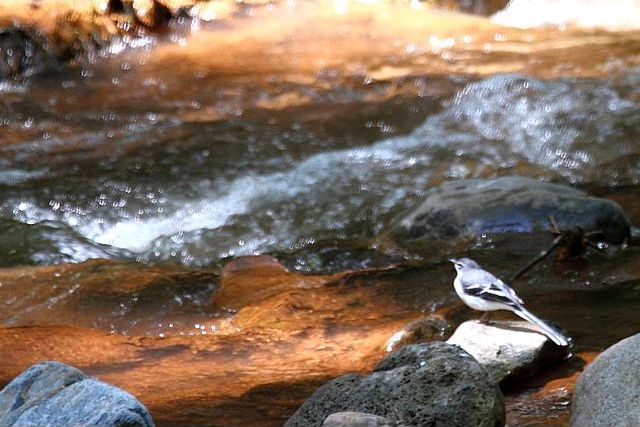
Links:
Sabap2
Species Text Sabap1: http://sabap2.adu.org.za/docs/sabap1/712.pdf
Newman's Birds of Southern Africa
SASOL VOELS VAN SUIDER AFRICA (3de UIT)

Links:
Sabap2
Species Text Sabap1: http://sabap2.adu.org.za/docs/sabap1/712.pdf
Newman's Birds of Southern Africa
SASOL VOELS VAN SUIDER AFRICA (3de UIT)


